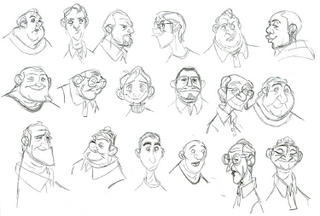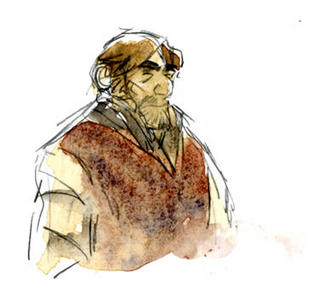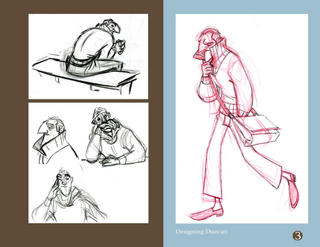James Robertson Interview
FLASH
Monday
BROUGHT TO YOU BY THE CHARACTER DESIGN BLOGSPOT
IF YOU WOULD LIKE TO SEE MORE CHARACTER DESIGNERS GO TO THE HOME PAGE BY CLICKING HERE
THE INTERVIEW

1. Tell me a little bit about yourself, about your life? Where did you go to school, and what classes did you study? What helped prepare you to become the artist that you are today?
I grew up in London Ontario, Canada. I attended BealArt which is an art high school program in London, where I got to do everything from photography to stitchwork. I started life drawing classes there in the 12th grade to prepare for Sheridan College. From there I spent 3 years at Sheridan College, where I drew pretty much all of the time. It was a great and challenging atmosphere, and a place I got a chance to really push myself. Most of my progression has taken place since then however, as I spend nights after work at my desk at home working on my own projects, and in cafes bettering my craft. I also have a great set of peers and collaborators that push me to better my work and my perceptions of art and filmmaking. I think everything else just boils down to hard work.
2. How do you go about designing a character, and what goes through your mind, from start to end? (Please be very detailed and in depth with this question)
Generally, when I design, it's for something I've written myself, so I have a fairly good idea who the character is, and what they mean to the story before I start drawing. But if that's not the case, and depending on the constraints of the production, that's the place to start. I start with the script, or outline, possible concept art as it may be. As you begin to imagine the character more thoroughly, traits begin to emerge. I tend to start really simply, just thinking broad terms about over all shapes and how to get the personality communicated in graphic terms. I also start loose drawing the character in poses to start thinking about the character's physical language and how forms and shapes will inevitably affect that, so that everything is doing the same thing in the design, and it's all talking about character. The more specific, the better.
3. What do you think really helps you out in designing a character?
Writing. At the beginning, I write as much as I draw. For me it's important to know the character as thoroughly as I can. I think you can tell a lot just by looking at a person, and as the designer, it's your job to control what people think and feel looking at your characters. To present a clear statement. In order to do that, you have to really know. It's the same process as making individual drawings I suppose. Work from the inside out.
4. From your own experience and maybe from some people that you know, what should we put in our portfolio and what should we not?
Well, fill a portfolio with the thing you're applying for, the thing you want to do. I think it comes down to whether you can do the job at the end of day, so think about that part of it, from their vantage point.
5. What are you working on now? (If you can tell us)
I work in a Flash studio during the day and on my own projects at night.
6. Where is the place you would like to work if you had a choice?
Pixar, which is a common answer I'm sure. Animagic in Spain looks amazing as well.
7. Who do you think are the top character designers out there?
There are so many. In no order, Sergio Pablos, Tony Fucile, Ricky Nierva, Teddy Newton, Peter Sohn, James Baxter, Joe Moshier, Chen yi-Chang, Craig Kellman, Chris Sanders, Harald Siepermann.
8. How do you go about coloring the character, what type of tools or media do you use?
I like Tria markers or watercolor for really hasty stuff. Photoshop for more polished, final stuff.
9. What type of things do you love to draw, and why?
Anything from life. The purpose varies according to my mental state, but drawing is primarily a joy,
so I draw whenever I can. I just love putting lines on paper.
10. What part of designing a character is most fun and easy, and what is most hard?
I think if you're doing anything right, it's all fun and it's all hard.
11. What are some of your favorite character designs and least favorite, which you have seen?
I love anything by Tony Fucile. I think Bob in Incredibles is a real high point. The old Milt Kahl /Ken Anderson stuff is stellar. Pretty much all of Robin Hood. I don't really have a least favorite. I tend to forget the things I don't favor.
12. What is your most favorite subject to draw?
People, they're always unique, and always interesting. Up to when I see them, there's a life story unfolding, so it's a joy to catch one frame of that on paper.
13. What inspired you to become a Character Designer?
I love to draw.
14. What wisdom could you give us, about being a character designer? Do you have any tips you could give?
The thing to remember is that you're designing a character, a personality, a consciousness, not merely shapes and colors. It's important to recognize that we're using symbols to convey meaning. So choosing symbols loaded with the appropriate biases is pretty essential, in that different physical traits in people and animals cause a correlated reaction in others. What meaning have we ascribed to big noses, broad chests, or thin eyes? Everyone has these preconceived notions of what these symbols mean; it's a matter of understanding that, and making proper use of them. In the 60's for example it was a definite statement to wear long hair, and having that, loaded your appearance with meaning, the point of being a radical political statement. I often see people that strike me as being genuine, or content, or malevolent or what have you. I think it's important to pay attention to those connections you make and use them in design. Like what makes someone look manipulative? Greedy? Warm? I think once you can answer that, you're on a good track to getting some pretty insightful designs done. To that end, I can think of no better study than sitting on a bench and observing people. I personally fill sketchbooks with fast sketches, as a means to understand people, and to record my reactions. I guess it's anatomy study of character in a way. I also think its important not to get too preoccupied with polish right away. Make bad drawings, and try to learn from them. It's all about slowly refining it and going towards something specific.
15. If people would like to contact you, how would you like to be contacted?
I have a blog at www.theironscythe.blogspot.com, my portfolio is linked from there. I would like to also add, that as a younger guy still very much learning the ropes, and this writing is something I humbly present as my opinions on the subject of design. I'm honored to contribute to this great forum, amongst these excellent artists in anyway I can.
Thanks.
IF YOU WOULD LIKE TO KNOW MORE ABOUT JAMES ROBERTSON GO TO
http://jmrobertson.ca/
http://www.theironscythe.blogspot.com/
CLICK HERE TO GO BACK TO THE CHARACTER DESIGN HOMEPAGE
Subscribe to:
Comments (Atom)











